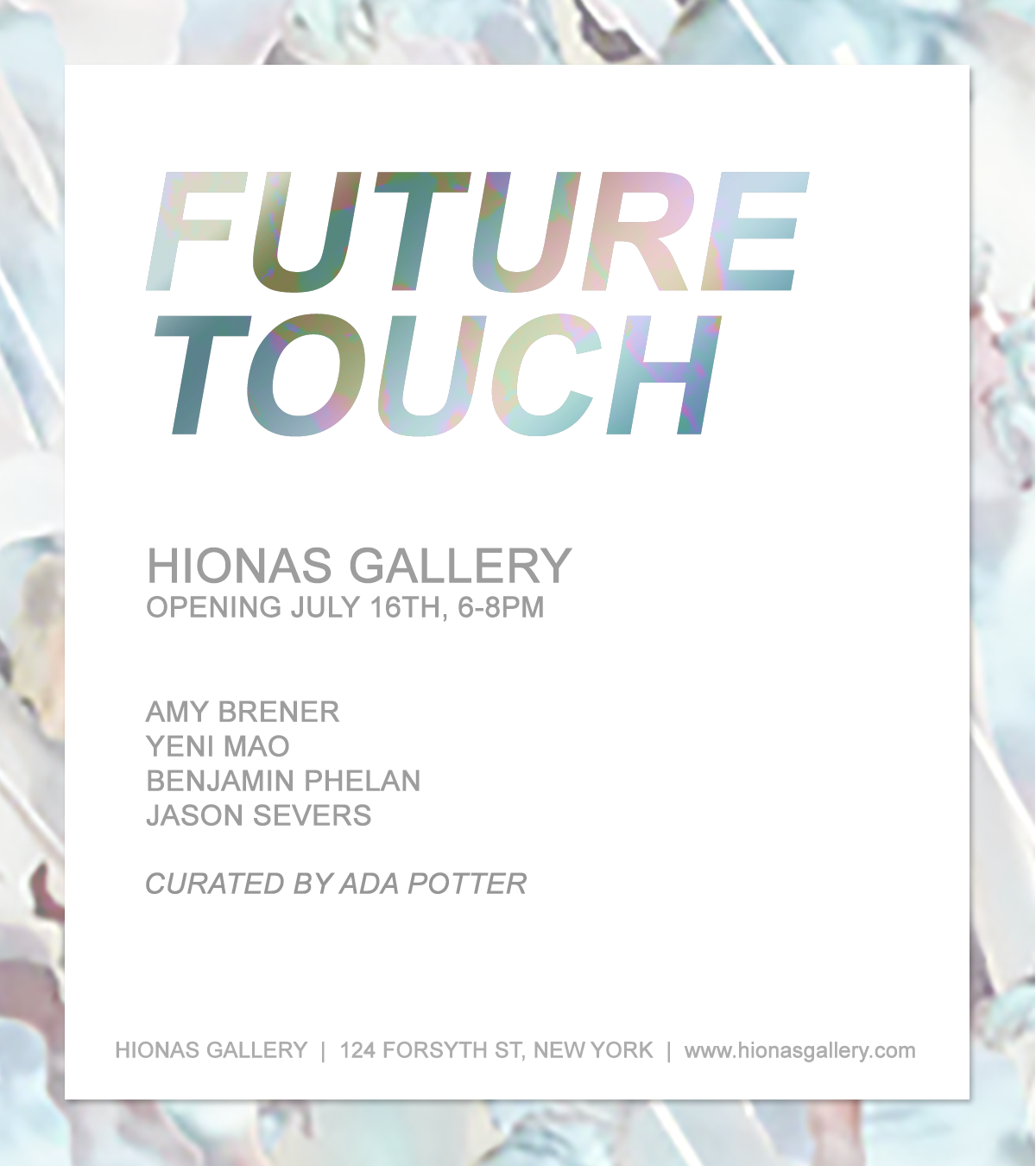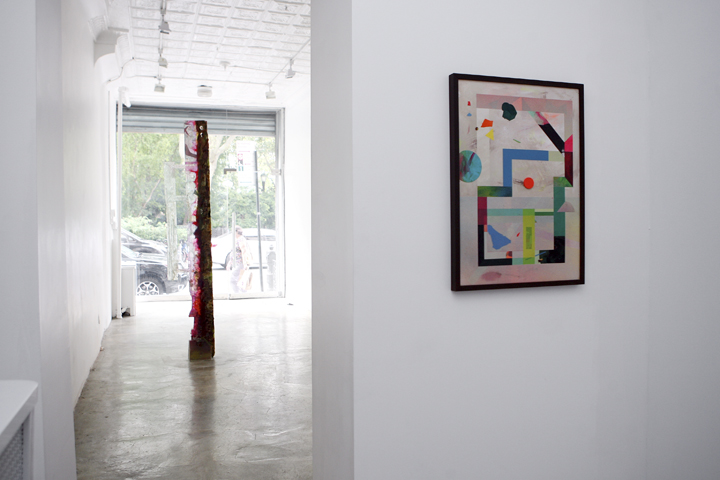
FUTURE TOUCH
Amy Brener, Yeni Mao, Benjamin Phelan and Jason Severs
Curated by Ada Potter
Hionas Gallery | 124 Forsyth Street, NY
Future Touch investigates what it means to look digital. New technologies have bred new aesthetics, which artists must somehow address. Each participating artist’s work seems to have been made by hands that understand an iPhone screen. Their work is animated by a futuristic or digital touch.
This diverse collection of work illustrates the pervasive quality of contemporary technology. Materials range from resins and Styrofoam to paint and collage, yet these physical objects are imbued with a hi-tech, ephemeral quality. In one sense, their forms make the often intangible tactile.
Amy Brener uses no digital processes in creating her work, yet her objects invoke a technology that is visually inescapable. This is also true of Yeni Mao, who uses more culture-specific material—in this case stills from Kung-Fu films—to create pictures that are at once undeniably analog, while at the same time come across as digital to the viewer’s screen-trained eyes.
Jason Severs, who is Executive Creative Director at Frog Design, also builds images using traditional art materials. But he uses tools like Photoshop, the iPad app Paper, and the software Processing to sketch with code. By utilizing the visual language that these programs imply he makes paintings that recall digital space. Similar to Severs, Benjamin Phelan uses software to model and CNC his sculptures. Phelan captures abstract gestures using motion capture spacial recording software that he then renders in Styrofoam and illuminates using prismatic LED gradients.
Regardless of their literal connection to technology, each artist is making a gesture that is mediated by digital terms. These individual, abstract gestures seem to project a new form of subjectivity into our technology-driven future.

Amy Brener, Proa, 2013, 92 x 17 x 7 in, Resin, foam, pigment, hydrostone, glass, plexiglass, found objects

Foreground: Amy Brener
Background: Yeni Mao,The Hustle, 2010, 42 x 32 in, Archival inkjet print collage on mylar

Yeni Mao,The Hustle, 2010, 42 x 32 in, Archival inkjet print collage on mylar

Amy Brener

Installation view

Jason Severs, Crooked Pyramids, 2014, 20.5 x 28.5 in, Mixed media on birch

Amy Brener, Bit, 2012, 15 x 38 x 2.5 in, Resin, gypsum, pigment, fresnel lens, found objects

Benjamin Phelan, Demo Center - RGB Phantom Sim Stick, 72 x 17 x 24 in, Extruded Styrofoam, iPhone, Activatar App, MetroCard

Installation View

Benjamin Phelan, Flux Discharge Index Cascade, 50 x 40 x 7 in, Extruded Styrofoam, LED pixel lighting system

Benjamin Phelan, Icosagon Mass Spile Driver, 101 x 28 x 31 in, Extruded Styrofoam, LED pixel lighting system
FUTURE TOUCH
Amy Brener, Yeni Mao, Benjamin Phelan and Jason Severs
Curated by Ada Potter
Hionas Gallery | 124 Forsyth Street, NY
Future Touch investigates what it means to look digital. New technologies have bred new aesthetics, which artists must somehow address. Each participating artist’s work seems to have been made by hands that understand an iPhone screen. Their work is animated by a futuristic or digital touch.
This diverse collection of work illustrates the pervasive quality of contemporary technology. Materials range from resins and Styrofoam to paint and collage, yet these physical objects are imbued with a hi-tech, ephemeral quality. In one sense, their forms make the often intangible tactile.
Amy Brener uses no digital processes in creating her work, yet her objects invoke a technology that is visually inescapable. This is also true of Yeni Mao, who uses more culture-specific material—in this case stills from Kung-Fu films—to create pictures that are at once undeniably analog, while at the same time come across as digital to the viewer’s screen-trained eyes.
Jason Severs, who is Executive Creative Director at Frog Design, also builds images using traditional art materials. But he uses tools like Photoshop, the iPad app Paper, and the software Processing to sketch with code. By utilizing the visual language that these programs imply he makes paintings that recall digital space. Similar to Severs, Benjamin Phelan uses software to model and CNC his sculptures. Phelan captures abstract gestures using motion capture spacial recording software that he then renders in Styrofoam and illuminates using prismatic LED gradients.
Regardless of their literal connection to technology, each artist is making a gesture that is mediated by digital terms. These individual, abstract gestures seem to project a new form of subjectivity into our technology-driven future.
Amy Brener, Proa, 2013, 92 x 17 x 7 in, Resin, foam, pigment, hydrostone, glass, plexiglass, found objects
Foreground: Amy Brener
Background: Yeni Mao,The Hustle, 2010, 42 x 32 in, Archival inkjet print collage on mylar
Yeni Mao,The Hustle, 2010, 42 x 32 in, Archival inkjet print collage on mylar
Amy Brener
Installation view
Jason Severs, Crooked Pyramids, 2014, 20.5 x 28.5 in, Mixed media on birch
Amy Brener, Bit, 2012, 15 x 38 x 2.5 in, Resin, gypsum, pigment, fresnel lens, found objects
Benjamin Phelan, Demo Center - RGB Phantom Sim Stick, 72 x 17 x 24 in, Extruded Styrofoam, iPhone, Activatar App, MetroCard
Installation View
Benjamin Phelan, Flux Discharge Index Cascade, 50 x 40 x 7 in, Extruded Styrofoam, LED pixel lighting system
Benjamin Phelan, Icosagon Mass Spile Driver, 101 x 28 x 31 in, Extruded Styrofoam, LED pixel lighting system











